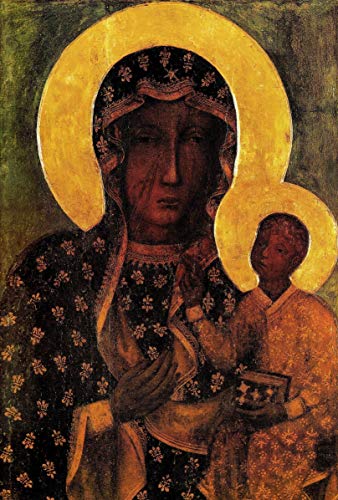 There are no historically certain facts concerning the origin and history of the picture until 1382, the year in which the picture was brought to Jasna Gora by Prince Ladislaus Opolczyk. One account which has been recounted numerous times of the origin of the icon being painted by the Evangelist Luke during Our Lady's lifetime. The image was allegedly painted on a wooden panel taken from a table used by the Holy Family at Nazareth. In the fourth century, the tradition continues, St. Helena, the mother of Constantine the Great was to have brought the picture to Constantinople, where it was held in great veneration and brought much comfort and and help in epidemic. Around the ninth century, the picture travelled northward, reaching Polish soil and finally resting in a castle in Belz, north-east of the city of Lwow (Leviv) in Red Ruthenia. Tradition tells us that while Prince Ladislaus of Opole was visiting these lands he found an ancinet miraculous picture of Our Lady in the private chapel of the Belz castle. The picture was damaged by an arrow. Urged by an inspiration, Ladislaus invited the Pauline Fathers from Hungary to come to Czestochowa in 1382. He built a temporary wooden shrine on the hilltop, known since then as Jasna Gora (Bright Mountain) and entrusted the picture of Our Lady to the care of the white-robed monks.
There are no historically certain facts concerning the origin and history of the picture until 1382, the year in which the picture was brought to Jasna Gora by Prince Ladislaus Opolczyk. One account which has been recounted numerous times of the origin of the icon being painted by the Evangelist Luke during Our Lady's lifetime. The image was allegedly painted on a wooden panel taken from a table used by the Holy Family at Nazareth. In the fourth century, the tradition continues, St. Helena, the mother of Constantine the Great was to have brought the picture to Constantinople, where it was held in great veneration and brought much comfort and and help in epidemic. Around the ninth century, the picture travelled northward, reaching Polish soil and finally resting in a castle in Belz, north-east of the city of Lwow (Leviv) in Red Ruthenia. Tradition tells us that while Prince Ladislaus of Opole was visiting these lands he found an ancinet miraculous picture of Our Lady in the private chapel of the Belz castle. The picture was damaged by an arrow. Urged by an inspiration, Ladislaus invited the Pauline Fathers from Hungary to come to Czestochowa in 1382. He built a temporary wooden shrine on the hilltop, known since then as Jasna Gora (Bright Mountain) and entrusted the picture of Our Lady to the care of the white-robed monks.
The image of Our Lad is painted on canvas in tempera colours. The icon's current state is due to extensive restoration from damage it incurred in 1430, when a band of marauders robbed the Jasna Gora shrine of many valuable votive gifts (mementoes) and fled with the miraculous picture. The picture was later rediscovered, according to tradition, the the site of today's St. Barbara's Church (also under the custodianship of the Pauline Fathers) where an allegedly miraculous stream flows by, not far distant from Jasna Gora. The picture was stripped of its precious ornaments, the base broken, and the canvas slashed with a sword. The Pauline Fathers brought the damged picture to Cracow to King Ladislaus Jagiello. The King took the responsibility of having the the picture restored. The restored pictured was painted without the crowns and costly dress which we see on recent paintings. The diamond studded dress was added in 1717 at the first coronation of the picture. The crowns were sent as a gift by Pope St. Pius X in 1910. Our Lady's face is dark, almost black. Its Origins remain a mystery. The colour is not actually, but father a dark bronze, like the colour of burnt grain. The expression on Our Lady's face is unforgettable. The historian Dlugosz described the Lady of Czestochowa as one of "the most gentle countenance, calling forth a profound sense of piety in those who gaze on here; it is as if you where looking at Our Lady alive." The scars on Our Lady's face are a permanent reminder of that sad incident of 1430. There are seven cuts in all: on the neck, on the face, and above the right eye.
The Mother of God seems to want us to know that she is the mother and queen of the a nation tortured and oppressed for ages. Like the seven swords that pierced here heard beneath the cross, the seven wounds adorn here Jasna Gora countenance. Throughout history, the icon of Our Lady of Czestochowa has been a source of inspiration and courage to many including Polish leaders of the army and the royalty She has helped them to achieve miraculous victories and feats, against all odds.